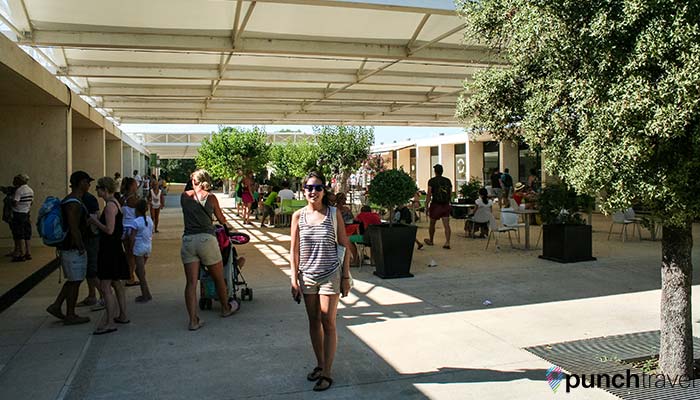Throughout the south of France, remnants of ancient civilizations have stood the test of time. About 90 minutes from Marseille and east of Avignon is the Pont du Gard, an ancient Roman aqueduct. It is notable as the highest of all elevated Roman aqueducts, and also one of the best preserved.

The history of the Pont du Gard
Constructed in 19 BC, it is part of the greater Nimes aqueduct and crosses the Gardon river. In ancient times, agriculture and civilization relied greatly on aqueducts to bring water from sources outside the city into the surrounding towns. Because of its significance, the Pont du Gard joined the list of UNESCO World Heritage Sites in 1985.
Much investment has been made towards not only preserving this venerable structure, but also towards building out the site as a major tourist destination in the Provence region of France. In addition to visiting the bridge, you can also visit a museum, garden and plaza with small souvenir shops and snacks for sale.
Visiting the Pont du Gard
On the hot mid-August day that we visited, the river banks were filled with children swimming in the river and families having picnics along the shore.

We arrived by car and parked in the parking lot so we ended up paying 18 euro total for full access to the grounds. Admission prices are a bit confusing because it is based upon what type of vehicle you arrive in and the number of people in your group.
Ticket prices for Pont du Gard (as of 2016):
- €18 for up to 5 people in 1 car
- €12 for visitors on motorcycles
- €7 for per person when arriving on foot or bicycle
- €15 (for 3 to 5 persons)
- €3.5 (per person for more than 6 persons)
- Discounted rates are available for students, unemployed, disabled and groups
- Prices are discounted in the evening when the stores and cultural areas are closed
After parking on the left bank, we walked through the shaded quarry towards the Pont du Gard. We passed by a small conference center as well as Les Terraces, a restaurant serving local Mediterranean cuisine.
What to see at the Pont du Gard site
As we continued along the river, we passed Grotte Salpêtrière, a grotto with remarkable cave drawings. The cave shows over six meters of habitation in layers representing 20,000 years of human existence between 30,000 and 10,000 BC. It is a significant site because one of the first engravings of animal depictions on bone to be found in France was discovered here.

Arriving at the left bank of the Pont du Gard, we climbed up to the entrance to prepare to cross to the other side. You can also take the small trail at the entrance which takes you even higher up to a scenic viewpoint.
The bridge has two pathways in which to cross: the lower pathway is wider and is the main mode of crossing. The higher pathway unfortunately is only available for groups or those on a special tour.

Making our way across the bridge, we were struck by the significance of such a structure. I am always impressed by how advanced our ancient ancestors were. The bridge has been carefully preserved and is in impressive condition for its age.
On the other side of the bridge is a small commercial area, with picnic tables, vendors selling ice cream and snacks, and souvenir shops. Two large panels proudly display the UNESCO world heritage sites in France, as well as the locations of other Roman structures you can visit.

Also on this side of the bank is a museum on the history of the Pont du Gard as well as Roman history and the aqueducts. The detailed exhibit explains all you need to know about aqueducts: how they work, how they were made, and the importance of these structures to Roman civilizations.

After checking out the museum, we explored the surrounding grounds. Majestic olive trees line the pathway leading to the surrounding farmland.

It is easy to stroll amongs the trees and be transported back in time. Throughout the grounds we discovered remnants of previous inhabitants, from a stone house to an old wall.

The Pont du Gard is open year round beginning at 8am with extended hours from May – September. The bridge is a magnificent sight to behold, and the museum, gardens and riverside make it a great destination for a full day out with the family.

Pin it!

















I am going to visit Pont Du Gard in September.